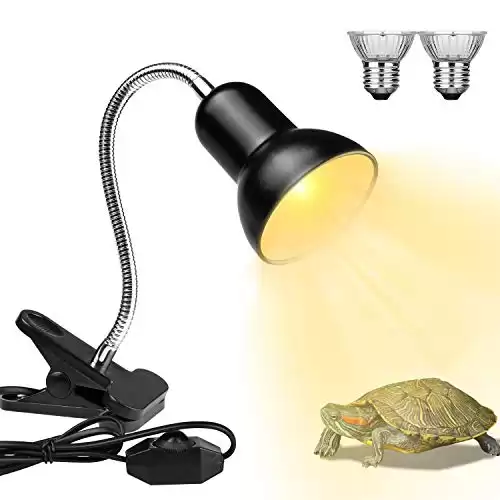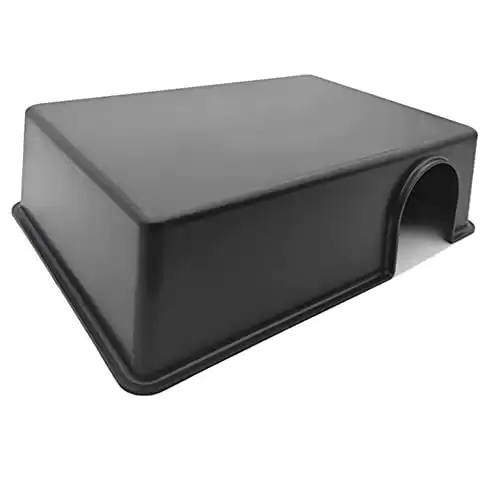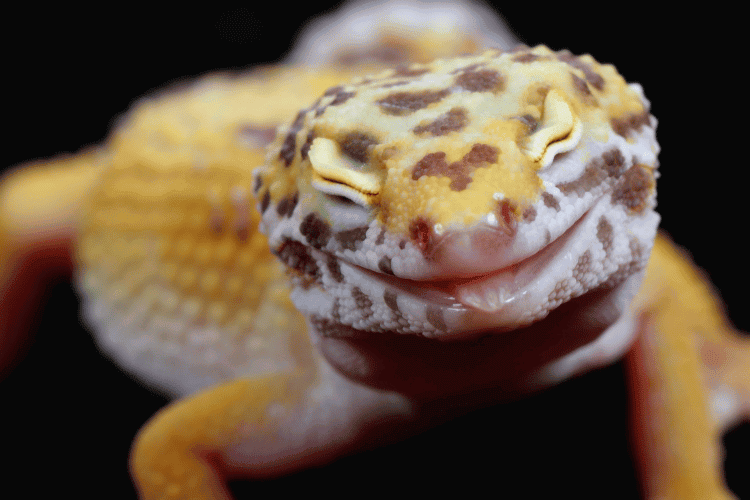
Leopard geckos are captivating creatures loved by reptile enthusiasts around the world. Their unique appearance, easy maintenance, and docile nature make them popular pets.
But have you noticed your leopard gecko’s eyes are closed (when it’s not eating)? This could be a sign of health issues that need investigating.
In this article, we’ll delve into the potential reasons why your leopard gecko eyes are closed and offer guidance on how to address them effectively, so stick around.
Underlying Issues in Leopard Gecko Health
The eyes of a leopard gecko are not only a window into its world but also a critical aspect of its overall health and well-being.
Proper eye function is essential for a leopard gecko’s survival in the wild, helping it detect prey, navigate its environment, and even communicate with other geckos.
Closed eyes and a lack of appetite are signals that something might be wrong, possibly related to an eye infection.
Understanding the potential causes behind closed eyes and loss of appetite can pave the way for effective care and intervention.
It’s important to monitor your gecko’s floor temperature and ensure the tank environment provides suitable conditions, avoiding both heat mats that could cause burns and cool temperatures that might lead to respiratory infections.
The Role of Eyelids in Leopard Geckos
Leopard geckos possess a unique feature that sets them apart from other species: eyelids. These movable eyelids allow leopard geckos to blink, providing a level of protection for their eyes.
While eyelids serve as a natural shield against potential hazards, they can also create an environment conducive to infections.
The presence of eyelids increases the surface area vulnerable to contaminants, making leopard geckos susceptible to various eye issues.
Warm water baths can be used to help ease discomfort and clean the eyes gently. Just make sure the water is at a suitable temperature, not too hot, and provide a moist hide afterward to create a humid microenvironment that can be soothing.
Recognizing and Addressing Eye Infections
Leopard geckos cannot vocalize their discomfort, making it crucial for owners to be observant of behavioral changes that may indicate an underlying issue.
Signs to watch for include:
- Constant Blinking: If your gecko is blinking excessively, it could be a sign of eye discomfort.
- Eye Licking: Persistent eye-licking might indicate irritation or the presence of a foreign object.
- Rubbing Behavior: Geckos rubbing their heads against surfaces could be trying to alleviate eye irritation.
- Lethargy and Hiding: Pain or discomfort can lead to lethargy, loss of appetite, and increased hiding.
- Discharge: Noticeable discharge from the eyes could point to an infection.
- Stuck Shed: Skin that remains stuck around the eyes can cause damage and potentially lead to infection.
Timely intervention is key to addressing eye infections and preventing complications.
Heat lamps and heat bulbs can help maintain appropriate temperatures, but uncontrolled growth of cells in the eyes can lead to conditions like corneal ulcers.
Understanding Different Eye Conditions
Leopard geckos can experience a range of eye conditions that contribute to closed eyes and loss of appetite. Understanding these conditions can aid in accurate diagnosis and effective treatment.
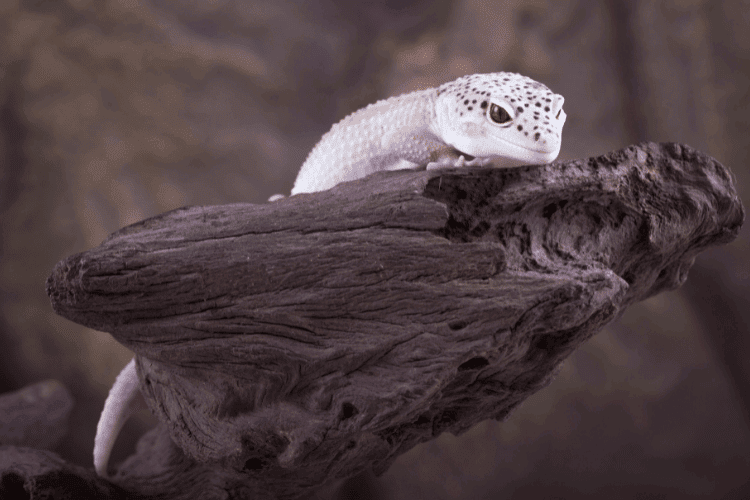
Some of the common eye conditions in leopard geckos include:
- Abscesses: Localized infections that can result from injuries or unsanitary conditions, abscesses require veterinary care for drainage and treatment.
- Blindness: While relatively rare, leopard geckos can experience blindness due to congenital anomalies, trauma, or illness. Blind geckos can still lead fulfilling lives with proper care.
- Conjunctivitis (Pinkeye): Bacterial infections of the conjunctiva can lead to cloudy eyes, discharge, and swollen eyelids. Hygiene, suitable conditions, and antibiotic treatment are essential for recovery.
- Dysecdysis (Shedding Issues): Shedding problems can lead to the accumulation of dead skin, causing damage and infection. Professional assistance is recommended for the safe removal of stuck shed around the eyes.
- Hypovitaminosis A: Vitamin A deficiency can lead to eye and skin issues. Prevention involves a balanced diet and supplementation, while treatment includes addressing the deficiency and incorporating Vitamin A-rich foods.
- Parasites: Parasitic infections can cause discomfort and closed eyes in geckos. Weight loss, reduced appetite, and loose stool are additional signs of infestations.
- Proptosis: Trauma can lead to an eye being dislodged from its socket, requiring veterinary intervention.
- Ulcers: Corneal ulcers are lacerations on the transparent cornea, requiring professional diagnosis and treatment.
Common Reasons for Closed Eyes and Loss of Appetite
Several factors contribute to the development of eye infections in leopard geckos:
- Physical Injury: The eyes of leopard geckos are delicate, and even minor physical injuries can lead to infections that lead to closed eyes and lack of appetite.
- Foreign Objects: Just as humans experience discomfort when something enters their eyes, geckos can also suffer from foreign object irritations. However, geckos lack tear production to naturally flush out debris, making assistance necessary to remove irritants and prevent complications.
- Rubbing and Scratching: Geckos may rub against surfaces in their enclosure to shed their skin or due to skin conditions like mites. This behavior can unintentionally lead to eye injuries, especially if the surfaces are abrasive.
- Hygiene and Environmental Conditions: Inadequate tank hygiene, incorrect temperature and humidity levels, and an imbalanced diet can contribute to eye-related problems. A clean environment, appropriate conditions, and a balanced diet are essential for preventing infections.
Taking Prompt and Appropriate Action
If you suspect that something might be wrong with your leopard gecko’s eyes, it’s important to take prompt and appropriate action to ensure their health and comfort.
1. Observe and Document
The first step is to closely observe your leopard gecko’s behavior and the appearance of their eyes.
Keep a record of any unusual behaviors, such as excessive blinking, rubbing their eyes against surfaces, or keeping their eyes closed for extended periods.
Additionally, note down any physical changes you observe in their eyes, such as cloudiness, discharge, or swelling.
Listening for unusual noises from your gecko can also provide insight into their well-being, avoiding future veterinary bills by catching issues early.
2. Isolate the Gecko
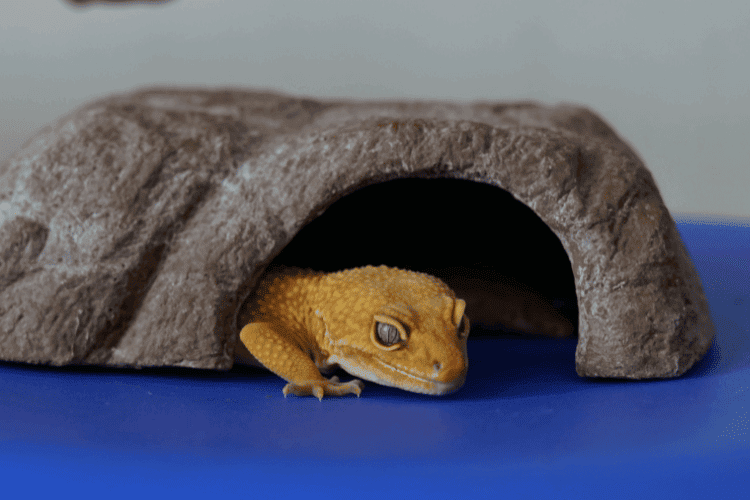
If you have other geckos in the same enclosure, consider isolating the affected gecko to prevent the potential spread of any infection.
This will also help you closely monitor the gecko’s behavior and provide the necessary care without interference from other tank mates.
3. Check the Tank Environment
Evaluate the conditions in your gecko’s enclosure. Ensure that the temperature and humidity levels are within the appropriate range for leopard geckos.
Poor tank hygiene and unsuitable substrate can contribute to eye issues, so make sure the tank is clean and the substrate is safe.
4. Consult a Reptile Veterinarian
If your leopard geck’o eyes are regularly closed when it’s not eating and you think it could be a sign of eye discomfort or infection, it’s very important to consult a veterinarian who specializes in reptile care.
A qualified reptile veterinarian will have the expertise to diagnose the issue accurately and recommend the appropriate treatment.
Avoid attempting to diagnose or treat the issue on your own, as improper handling can exacerbate the problem.
5. Provide Supportive Care
While waiting for your veterinary appointment, you can provide some supportive care to alleviate your gecko’s discomfort.
Create a moist hide by placing damp paper towels or a piece of moss in a hide box. This can help create a humid microenvironment that may be soothing for your gecko’s eyes.
6. Avoid DIY Remedies
Avoid applying any over-the-counter medications or remedies without consulting a veterinarian. The eyes of leopard geckos are delicate, and using inappropriate products can worsen the issue.
7. Follow Veterinary Recommendations
After your visit to the veterinarian, follow their recommendations for treatment. This may include administering prescribed eye drops or ointments.
Make sure to administer the medication as instructed and follow up with any recommended appointments.
8. Monitor Progress
Keep a close watch on your gecko’s progress during and after treatment. Document any changes in behavior, eye condition, or appetite.
If there are any concerns or if the condition doesn’t improve, don’t hesitate to contact your veterinarian for guidance.
9. Preventive Measures
To prevent future eye issues, maintain proper tank hygiene, provide a suitable substrate, and ensure the right temperature and humidity levels.
Offer a varied and balanced diet to promote overall health.
10. Be Patient
Recovery from eye issues may take time, so be patient with your gecko.
With proper care and attention, many eye-related problems can be successfully resolved, and your gecko can return to its vibrant and healthy self.
Wrapping Up
Closed eyes and loss of appetite in leopard geckos can be quite distressing for owners, but with a thorough understanding of potential causes and proper care strategies, these challenges can be overcome.
Keeping a clean and suitable environment, offering a balanced diet, and addressing shedding issues are fundamental for preventing eye-related problems.
If you suspect that something is wrong with your leopard gecko’s eyes, taking immediate action is crucial. Consulting a reptile veterinarian and providing appropriate care can make a significant difference in your gecko’s well-being.
By staying vigilant and providing dedicated care, as indicated in this article, you can enjoy the companionship of your vibrant and healthy leopard gecko for many years to come.

